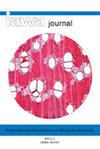Variations in tension wood characteristics of Populus alba under alternate bending, nitrogen fertilization, and gibberellin treatments
IF 1.4
3区 农林科学
Q2 FORESTRY
引用次数: 1
Abstract
Reaction wood formation (tension wood) in trees such as poplar is a response to stress and environmental factors. Tension wood is a rich source of cellulose that can be used for products including paper or biofuels and is thus a target product in forestry. This study aimed to evaluate the formation of tension wood in two-year-old saplings of Populus alba by using alternate bending, nitrogen fertilization, and gibberellin hormone. Saplings were bent alternately in one or another direction every month during the growing season, fertilized twice at the beginning and in the middle of the growing season, and treated with gibberellin early in the growing season. The physical and anatomical characteristics of the wood were studied after the end of the growing season. Evaluation of transverse sections of specimens stained with safranin/Astra-blue showed that, compared with straight saplings, alternate bending saplings had a wider tension wood area in the growth ring and clear formation of a gelatinous layer. The wood of alternate bending saplings with nitrogen fertilization and gibberellin hormone had a higher wood density, greater longitudinal shrinkage, and less radial and tangential shrinkage than saplings with other treatments. Moreover, the alternate bending saplings treated with nitrogen fertilization and gibberellin hormone had tension wood with the largest vessels, the lowest vessel density, and the smallest total vessel lumen area than saplings with other treatments. Wood fibers of treated saplings also had the thickest wall with the smallest fiber and lumen diameters. Overall, the bending treatment with the addition of nitrogen fertilization and gibberellin hormone was the most effective for the stimulation of tension wood formation in terms of volume and intensity.交替弯曲、氮肥和赤霉素处理下白杨拉伸木材特性的变化
杨树等树木的反应性木材形成(张力木材)是对压力和环境因素的反应。耐张木材是纤维素的丰富来源,可用于造纸或生物燃料等产品,因此是林业的目标产品。本研究旨在通过交替弯曲、施氮和赤霉素激素来评估白杨两岁幼树耐张木材的形成。在生长季节,每个月将幼树交替地向一个或另一个方向弯曲,在生长季节开始和中期施肥两次,并在生长季节早期用赤霉素处理。在生长季节结束后,对木材的物理和解剖特征进行了研究。对用藏红/阿斯特拉蓝染色的标本横截面的评估表明,与直树苗相比,交替弯曲的树苗在生长环中具有更宽的受拉木材区域,并明显形成凝胶层。与其他处理相比,施用氮肥和赤霉素激素的交替弯曲幼树的木材密度更高,纵向收缩更大,径向和切向收缩更小。此外,与其他处理的幼树相比,施用氮肥和赤霉素激素处理的交替弯曲幼树具有最大血管、最低血管密度和最小总血管管腔面积的张力木。经处理的树苗的木纤维壁也最厚,纤维和管腔直径最小。总体而言,就体积和强度而言,添加氮肥和赤霉素激素的弯曲处理对张力木材的形成最有效。
本文章由计算机程序翻译,如有差异,请以英文原文为准。
求助全文
约1分钟内获得全文
求助全文
来源期刊

IAWA Journal
农林科学-林学
CiteScore
3.40
自引率
15.80%
发文量
26
审稿时长
>36 weeks
期刊介绍:
The IAWA Journal is the only international periodical fully devoted to structure, function, identification and utilisation of wood and bark in trees, shrubs, lianas, palms, bamboo and herbs. Many papers are of a multidisciplinary nature, linking
 求助内容:
求助内容: 应助结果提醒方式:
应助结果提醒方式:


